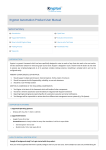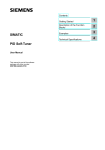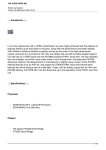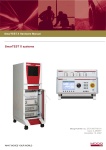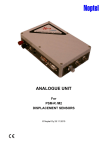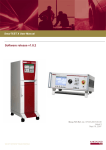Download ReaGeniX User`s Manual
Transcript
ReaGeniX
Programmer 2.0
A Real-Time Application Generator
User's Manual
14.4.2000
OBP Research Oy
Teknologiantie 10 D, 90570 OULU, Finland
Tel. +358 8 551 5540
http://personal.inet.fi/business/obp/index.htm
2
ReaGeniX Programmer User’s Manual
Copyright 1999 OBP Research Oy
ReaGeniX is a trademark of OBP Research Oy.
Visio is a registered trademark of Visio Corporation.
Windows is a trademark of Microsoft Corporation.
OBP Research Oy does not guarantee merchantability or fitness of the
ReaGeniX Programmer to any particular purpose. There is no warranty by OBP
Research Oy or any other party or person that the functions contained in the
software will meet your requirements or that the operation of the software will be
uninterrupted or error-free. You assume all responsibility for the selection of the
software to achieve your intended results, and for the installation, use and
results obtained from it.
Our policy is continuous improvement. This can cause slight differences
between appearances of actual symbols in the documentation and in the
distributed software.
ReaGeniX Programmer v. 2.0
3
TABLE OF CONTENTS
1.
2.
3.
INTRODUCTION
7
1.1
Background
7
1.2
Purpose of manual
7
1.3
Scope of Application
7
1.4
Components of ReaGeniX Visual Programmer
8
GETTING STARTED
2.1
Modelling an Automatic Door Controller
2.2
Compilation
REAGENIX COMPONENT
9
9
15
16
3.1
Actor component specification
16
3.2
Ports
16
3.2.1
Time Discrete Communication
17
3.2.2
Time Continuous Communication
17
3.2.3
Shared Data Store
18
3.2.4
Control (Enable)
18
3.3
Port symbol
19
3.4
Component body
21
4.
APPLICATION DESCRIPTIONS BY REAGENIX
22
5.
STATE TRANSITION DIAGRAM
23
User's Manual
4
5.1
Local Declarations
24
5.2
State
24
5.2.1
5.3
5.4
6.
24
Transition
25
5.3.1
Initial transition
26
5.3.2
Transition condition
26
5.3.3
Transition action
27
Indexing in state transition diagrams
29
5.4.1
Operations on indexed objects
29
5.4.2
Indexed transition
30
ARCHITECTURE DIAGRAM
6.1
31
Subcomponents
32
6.1.1
33
Selector
6.2
Connections
34
6.3
Stores
34
6.4
7.
Transition node
6.3.1
Store declaration
34
6.3.2
Accessing a store
35
6.3.3
Scope of names
36
Indexing in architecture diagrams
36
6.4.1
Indexed subcomponents
37
6.4.2
Connections to indexed ports
37
6.4.3
Connections to indexed subcomponents
37
6.4.4
What is really connected to which and how
39
INITIALISING SYSTEM VARIABLES
ReaGeniX Programmer v. 2.0
41
5
8.
9.
7.1
explicit initialisation
41
7.2
implicit initialisation
41
7.3
explicit uninitialisation
41
MODELLING EXAMPLES
42
8.1
A simple test environment
42
8.2
A Compound System: a Traffic Light Controller
46
8.3
Component instancing: Ping-Pong
51
8.4
Data Processing: a Weighing System
52
8.5
Connecting to Real-Time and Real-World
55
8.6
Indexing: A Mass Storage Multiplexer
58
APPENDIX 1
9.1
ReaGeniX components for Prosa tool
User's Manual
61
61
6
DOCUMENT CONVENTIONS
This manual uses the following typographic conventions.
Example of convention
Description
duration_max, boolean
In syntax, words in bold indicate
language specific keywords.
duration_max, boolean
In text, this font is used for
language specific keywords and
names referring to examples.
duration_max, boolean
In text, this font is used for
language specific examples.
parameter file
In text, italic letters are used for
defined terms, and occasionally
for emphasis.
parameter_file
In syntax, italic letters indicate
placeholders for information you
supply.
[name]
In syntax, items inside square
brackets are optional.
name | name
In syntax, a vertical bar
indicates a mandatory choice
between two or more items. You
must choose one of the items
unless all of the items also are
enclosed in square brackets.
{name}
In syntax, items inside braces
are repeated at least once.
ReaGeniX Programmer v. 2.0
7
1.
INTRODUCTION
1.1 Background
Embedded software is an essential part of modern electronic products, such as
mobile phones, lifts and domestic applications. Embedded software is often
called real-time software because it has a continuous interaction with its
environment and it often has strict response time requirements.
The behaviour of real-time programs differ from the sequential programs and
therefore the design and testing of such software require special languages and
tools to avoid reliability problems.
1.2 Purpose of manual
The purpose of this manual is to give detailed instructions how to create realtime applications by using ReaGeniX Modelling Language and Visual
Programmer.
The ReaGeniX Modelling Language (RML) is aimed for modelling and
implementation of real-time systems. The models may range from abstract
prototypes to the implementation. The ReaGeniX Visual Programmer is a tool
for compiling of such models to the executable prototypes or to the final
production code.
The ReaGeniX Modelling Language is a visual language, which is based on
communicating hierarchical state machines. Each state machine has a well
defined interface describing a component, which can be freely instantiated in
higher level components (i.e. context-free components).
The ReaGeniX Visual Programmer translates the RML components to C/C++
program modules. The computation and data types used in RML are written in
C/C++ using a predefined macro library and they are used as such in the
produced code.
The best performance of the code produced by the ReaGeniX Visual
Programmer can be achieved by the use of ReaGOS real-time operating
system. However, the produced code is independent of operating systems and
therefore it can be used with the most real-time operating systems.
1.3 Scope of Application
The ReaGeniX Visual Programmer can be used to produce code for hard realtime and embedded computer systems. The application areas include, but are
User's Manual
8
not limited to: control, measurement, sequence control, process simulation,
and data communications.
ReaGeniX Visual Programmer can be used in quick prototyping, demonstration,
validation of specifications and intermediate designs, and final implementation.
1.4 Components of ReaGeniX Visual Programmer
ReaGeniX Visual Programmer consists of following parts:
Visiopath\Solutions\Reagenix\reagenix.vss - a Visio stencil for
ReaGeniX Modelling Language
Visiopath\Solutions\Reagenix\Rgx3w.vst or Rgx4h.vst - templates
which use the reagenix.vss
Visiopath\Solutions\Reagenix\reagenix.exe - a Visio add-on, which
reads the diagram information from Visio -tool using OLE2 interface into
pagename.vis file. The ReaGenix add-on should reside in one of Visi addon paths (see Installation Guide for editing
visiopath\System\visio.ini), which calls rgxbat.bat after
conversion.
Rgxpath\Visio5\gener\rgxmsg.exe - a Windows executable for viewing
the ReaGeniX warnings and error messages (file pagename.err).
Opens the diagram page in Visio and shows the object. The error
message is referring by selecting it. Works best if to be assosiated in
Windows with .err files.
Rgxpath\Visio5\gener\rgxbat.exe - a Windows executable file called
by reagenix.exe add-on. Parameters for batch file are:
1.
The directory where the Visio model to be generated is.
2.
Page name of generated diagram (used for file names).
Rgxpath\Visio5\gener\vis2rgx.exe - a MSDOS executable converting
visio format diagram information into ReaGeniX (.rgx) format (run by
rgxbat.exe).
Rgxpath\Visio5\gener\rgx2c.exe - a MSDOS executable generating C code from ReaGeniX (.rgx) format (run by rgxbat.exe).
Visiopath\Solutions\Reagenix\reagenix.hlp – a shape help for
reagenix.vss.
ReaGeniX Programmer v. 2.0
9
2. GETTING STARTED
2.1 Modelling an Automatic Door Controller
The problem:
You should design an automatic controller for a market door. You have a
door machinery and a radar. The door machinery is controlled by a two
state electrical relay (a flag for now on). If the flag is high, the servo drives
the door open. If the flag is low, the servo drives the door closed. The
radar output is also a flag. If the radar senses something within its range,
the output flag is high, otherwise low.
If the radar senses something, the door must be driven open. The door is
allowed to close after 3 seconds has elapsed after the last indication of
something within the range of the radar.
A state machine is the solution for a simple sequence control problem like this.
State machines are the basic building blocks of a ReaGeniX system
description. A state machine reacts to events with computation, control, output,
and updating internal and external data. An event may be considered something
happening outside of the system, e.g. closing a door or elapsing of a
predetermined waiting time. However, a state machine sees an event as arrival
of data or a signal or firing of an internal timer and it can react to all of them. A
state-transition diagram is a picture of a state machine.
The main parts of a state machine are states and transitions. The states are
drawn as boxes and the transitions are drawn as arrows in a state transition
diagram. In a state machine, one of the states is the current state at a
particular point of time. The possible responses of the state machine are
defined by the transitions leading from the current state.
User's Manual
10
initial action;
State1
condition =>
transitio1 action;
condition =>
transition2 action;
State2
Figure 1: A state transition diagram.
A transition leading from the current state may be fired, if the condition of the
transition holds. When a transition is fired, the state, which the transition leads
to, becomes the new current state. Moreover, the actions of the transition are
executed. The condition and action are defined textually and the condition is
separated from action with an arrow ( =>) .
It is convenient to visualise the operation of a state machine moving a paper clip
on a state transition diagram. The paper clip is moved from the old current state
to the new current state following the arrow of the fired transition.
An action is a piece of program written in C-language. It may perform any
computation, output data, modify stores both internal and external to the state
machine, and control other components.
ReaGeniX Programmer v. 2.0
11
l(keep_open);
closed
when(v(somebody))
=>
r(keep_open);
when(timeout(timer))
=>
l(keep_open);
people_detected
when(!v(somebody))
=>
ov(timer)=3*Second;
when(v(somebody))
=>
give_time_to__pass
Figure 2: Automatic door state transition diagram .
In Figure 2, there is a state-transition diagram for automatic door control. Here
we can see three states and four transitions. One of the transition arrows starts
from nowhere. It is the initial transition. The initial transition defines what is done
when the state machine is started.
A new state transition diagram is created with Visio tool using the stencil
provided by ReaGeniX delivery. It is assumed here that the reader has the basic
knowledge of using Visio Tool. Figure 3 shows the state transition diagram in
Visio tool. The symbols in stencil can be seen on the left. The symbol is
imported in the diagram by drag and drop.
User's Manual
12
Figure 3: A state transition diagram in Visio.
A diagram in ReaGeniX for Visio is drawn in separate page. The name of page
is important for code generation purposes and a page name of maximum 8
letters is recommended. The symbols of the ReaGeniX stencil usually have a
right mouse button menu which contains the most common operations for the
symbol. Usually one of these is editing the custom properties, which are asked
every time a new symbol instance is created into diagram.
In addition to states and transitions, a complete state transition diagram
includes a component body, a component specification, and local variable
declarations. A component body is represented by a rectangle around the state
machine. A component specification is a broken-line box. A local variable
declaration represented by a textual declaration. An example of complete model
is presented in Figure 4.
ReaGeniX Programmer v. 2.0
13
Every diagram must have exactly one component body symbol, which names
the component type that the diagram describes (here shopdoor). A
component specification defines all the connections between the new
component type and its environment. A textual declaration is used to define the
local variables whose value is to be retained between transitions. The timers are
also declared using textual declaration.
flag somebody
shopdoor
flag keep_open
shopdoor
timer timer
l(keep_open);
closed
when(v(somebody))
=>
r(keep_open);
when(timeout(timer))
=>
l(keep_open);
people_detected
when(!v(somebody))
=>
ov(timer)=3*Second;
when(v(somebody))
=>
give_time_to__pass
Figure 4: Automatic door control diagram for ReaGeniX.
In the shopdoor component specification there is one input port (a triangle
pointing inwards), a flag called somebody which tells, whether somebody is
User's Manual
14
seen near to the door. A flag may have Boolean values true and false. Here it is
assumed that the value false means that nobody is seen and the value true
means that somebody is seen.
To avoid conflicts with standard Windows header files ReaGeniX uses names
R_boolean, R_false, and R_true for Boolean type and values.
There is also one output port (a triangle pointing outwards) a flag called
keep_open. It is used to command the physical door either open or closed.
Here it is assumed that the value R_false commands the door to close or
keep closed and the value R_true commands the door to open or keep open.
One timer trail_timer is declared. A timer is a variable whose value is
automatically decrement in pace of real-time.
When the door controller is enabled (= switched on), the initial transition is fired
and its action, the statement send(keep_open)=R_false; is executed.
The statement sends the value R_false to the output port to keep the door
initially closed.
Therefore, the controller is first in the state closed. From this state, only one
transition is possible. If somebody appears in the detection range, the condition
when(v(somebody)) causes the transition to fire. A person in the detection
range is seen by the state machine so that flag somebody raises to R_true.
The operator v() access the value of the port and the condition operator
when() reacts to the value R_true of the argument. Consequently the action
send(keep_open)=R_true; causes the door to open. Finally, the machine
is settled in the state people_detected.
When the people has passed clear of the detection range, the expression
!v(somebody) becomes R_true and the next transition is fired.
ov(trail_timer)=3*Second; sets timer to fire in 3 seconds. The physical
door is not affected at this moment.
The machine can wait maximum of 3 seconds in the state
give_time_to_pass. If somebody appears in the detection range during the
wait the machine returns to people_detected, otherwise the timer fires,
timeout(trail_timer) becomes R_true, the door is commanded to
close, and the machine returns to the state closed.
The diagram of the automatic door controller is found from the distribution media
as exampl01\shopdoor.vsd.
ReaGeniX Programmer v. 2.0
15
2.2 Compilation
To store the generated code make a working directory, called workpath.
Check that ReaGeniX Visual Programmer is in the Tools-Run Add-on menu. If
it is not you must modify the file Visio.ini
AddonsPath= rgxpath\Visio\add-on
To generate code from Visio Diagram select command from menu Tools-Run
Add on -ReaGeniX (see Visio documentation for details of running add-ons).
The ReaGeniX Visual Programmer produced files .C and .H for each diagram:
.C file contains the program code.
.H file contains the data declarations and function prototypes.
The base of filenames is defined by name of the Visio page of the diagram.
ReaGeniX uses macro library REACTIME.H and a parameter file REACTIME.P,
both of which are found in rgxpath\INCLUDE. These files must be included in
the main program. No special run-time libraries are needed.
A simple test environment is provided with the ReaGeniX Visual Programmer to
execute the generated program. The instructions ara provided in Appendix 1.
User's Manual
16
3.
REAGENIX COMPONENT
3.1 Actor component specification
flag b_green
flag b_amber
flag b_red
A component specification describes the interface of a new component type.
The interface consists of communication channels defined by named ports. In
ReaGeniX language, all components are actors so the name actor and
component are used without distinction. An actor specification symbol is a
rectangle into which the port symbols are snapped to.
sequence_lights
flag ped_request
flag ped_red
flag a_green
flag a_red
flag ped_green
flag a_amber
flag ped_grant
Figure 5: An actor component specification.
3.2 Ports
A port defines the direction, name, class and datatype of a communication
channel in actor component interface. A communication consists normally of
associated data value and event.
An actor component can respond to an event in a communication channel in its
interface. A data associated with communication can be used as a basis of
calculations inside component. A component can read the data associated with
communication channel when the component is activated by an event, but a
change in data without event cannot trigger a response. The event that activated
the component need not always be in the same communication channel from
which the data is read.
ReaGeniX Programmer v. 2.0
17
Depending on the event time behaviour of data in communication channel the
basic communication mechanisms are divided into basic classes (or connector
types):
•
Time Discrete communication
•
Time Continuous communication
•
Store
•
Control
3.2.1 Time Discrete Communication
A discrete communication passes messages from the sender to the receiver.
The data is passed, if the receiver component is waiting for the data at the
moment of transmission, otherwise, the data is lost. The message and the
accompanying event are not buffered in any way. The sender is not affected by
the successful reception or the loss of data. The datatype of data value is
specified when declaring a port of type discrete communication.
Event
Value
Time
A special case of discrete communication is a signal, it has no data value
associated to the event.
Value
Event
Time
3.2.2 Time Continuous Communication
A continuos communication has a value at any time. It retains its value until a
new value is sent. The receiver can read its value whenever it needs to. An event
is associated to the change of the value so, that the receiver can immediately
react to the new value.
User's Manual
18
Event
Value
Time
A special type of continuous data is a flag whose datatype is Boolean and need
not to be specified in declaration.
Value
Event
True
False
Time
3.2.3 Shared Data Store
A shared data store can be accessed from several components. It retains its
value until changed. No event is associated to the change of the value. It is
impossible to immediately react to the change of the value, without other kinds
of signalling.
Value
Time
3.2.4 Control (Enable)
Controls are used to switch a component on and off. Controls cannot be
branched or merged.
Value
Event
Enable
Disable
Time
Switching a component off means immediate killing of the component with
complete loss of data values and state information within the killed component.
However, data in continuous communications and stores outside the killed
component retain their values.
ReaGeniX Programmer v. 2.0
19
Switching a component on means full reset of the component. The data in
stores and continuous communications inside the component are set to initial
values and initial transitions of the state machines are executed.
3.3 Port symbol
A declaration of port consist of:
[direction] connector_type portname[index_name][:datatype]
ActorClassName
discrete portname:datatype
Figure 6: A port.
A port symbol is a small triangle snapped to component specification symbol
(Figure 6)
direction of port is shown visually by the direction of triangle. The direction of
port can be changed from right button menu and from custom properties:
Triangle head to the component for input port
Triangle head from the component
for input port
connector_type is selected from symbol specific custom property window
(right button menu):
discrete
for time discrete communication
continuous
for time continuous communication
store
for stores
signal
shorthand for discrete communication with no data
value
flag
shorthand for continuous Boolean valued
communication
control
for component enable/disable
port name identifies the name of the port that must be unique (local) for this
component. datatype is used for discrete and continuous connections. datatype
User's Manual
20
is either a C standard datatype or it is declared in an included C header file
(with typedef). port name and datatype are written in text property of port
symbol.
For C -datatypes used in port declarations a diagram must have a textual
declaration symbol (see ch. 0) where the name of header file where to find the
datatype is told, e.g.:
include ctypes.h
A port can be indexed. A indexed port consists of ports with the same
connector type and datatype who are separated by port index. An indexed port
has a separate event and data value for each index. Note that a port with C array type has only one event. index name must be declared with textual
declaration symbol (see ch. 0) before it can be used in port declarations in a
diagram, e.g.:
index I :< ntrans
defines index I so that its range is 0..ntrans-1. The syntax of an index
definition clause is
index_variable :< repeat_count
where index_variable is a legal C variable name and repeat_count is a constant
expression that can be evaluated during C compilation. The repeat_count may
contain symbols defined in an included header file. The definition makes the
lower bound of the index_variable to be 0 and the upper bound to be
(repeat_count -1) inclusive.
ReaGeniX Programmer v. 2.0
21
3.4 Component body
An actor component body symbol is used to describe the implementation of a
component type. The actor body symbol is used to draw a border around a
state transition or an architecture diagram in ReaGeniX language.
ActorClass
Figure 7: An actor body symbol.
In ReaGeniX diagrams, the component type symbol is used to represent the
interface of component for connections to the outside world. The ReaGeniX
state transition diagrams and architecture diagrams are drawn inside the
component body symbol. The name of component type is written in text custom
property of actor body symbol. Usually ReaGeniX diagram has an actor body
and actor specification, which have a same name.
User's Manual
22
4.
APPLICATION DESCRIPTIONS BY REAGENIX
The application descriptions made by ReaGeniX consist of two major diagram
types, architecture diagrams (AD) and state-transition diagrams (STD). A
ReaGeniX diagram always defines a new component type. It is thus possible to
form a library of re-usable components.
State-transition diagrams describe the dynamics and the computation of the
system. A state transition diagram describes an elementary sequential process
called a state machine.
Architecture diagrams describe the structure of a system. An architecture
diagram describes a higher level process composed of concurrent lower level
processes called actors some of them might be described as state machines.
An actor symbol in architecture diagram defines a component instance. There
may be several component instances of the same component type in a system
The hierarchy of architecture diagrams may be arbitrarily deep. Actually, the
depth may be limited by the C-compiler used to compile the results of the
ReaGeniX Programmer.
The processes are connected together by communication mechanisms. The
communication mechanisms available in the ReaGeniX language are
•
shared data stores
•
discrete communication including signals
•
continuous communication including flags
•
control (enabling/disabling a component)
Discrete and continuous communication and control carry an event. It means
that a state machine can immediately react to
•
change of the value of a continuous input
•
new data (even if the same value) in a discrete input
•
enabling via an control
Moreover, a ReaGeniX component can react to a timeout using a timer concept.
A change of the value of a store cannot be immediately reacted to. The value of
a store can be tested in a reaction to some event e.g. to a timeout of a timer.
However, high frequency polling of a store results computationally heavy
implementation and should be used with discretion.
ReaGeniX Programmer v. 2.0
23
5.
STATE TRANSITION DIAGRAM
A state transition diagram defines a state machine. State machine reacts to
events with computation, control, output, and updating internal and external
data. An event may be considered something happening outside of the system,
e.g. closing a door or elapsing of a predetermined waiting time. However, a
state machine sees an event as arrival of data, a signal, or firing of an internal
timer, and it can react to them all.
flag somebody
shopdoor
flag keep_open
shopdoor
timer timer
l(keep_open);
closed
when(v(somebody))
=>
r(keep_open);
people_detected
when(!v(somebody))
=>
ov(timer)=3*Second;
when(v(somebody))
=>
give_time_to__pass
Figure 8: A State Transition Diagram.
User's Manual
when(timeout(timer))
=>
l(keep_open);
24
A state transition diagram consists of states, transitions, timers and local
stores.
5.1 Local Declarations
A textual declaration of form:
store storename:datatype[:=initializer];
declares a local state variable in state transition diagram. Each time the state
machine is reset, the initializer value is assigned to the variable. The initializer
can be omitted, if the type has a default initializer, or the type is explicitly
uninitialized. See section initial values.
A textual declaration of form:
timer timername[:=initializer];
declares a timer. A timer is initialised like a store. The default initializer is 0.
A timer is almost like a store of type duration whose value decreases with
passing of time. A timer produces an event when its value reaches zero.
Value
Event
Time
5.2 State
A state is used to define waiting. In a state, a state machine can wait for an
external event or a condition to hold. The different states of a state machine
represent different ways to react to the same kind of events. States are drawn
as boxes in a state-transition diagram. The states are given descriptive C
names.
If a state machine is enabled, one of the states is called current state.
5.2.1 Transition node
Transitory states are used if a transition should branch to several states based
on Boolean conditions, or several transitions should join, or a combination of
both is needed.
ReaGeniX Programmer v. 2.0
25
ready_b
else =>
r(b_amber);
ov(timer) = 1*Second;
when(timeout(timer)) =>
all_red_again
else =>
all_red_once_more
when(timeout(timer)) =>
when(v(ped_request)) =>
l(ped_red); r(ped_green); r(ped_grant);
ov(timer) = 10*Second;
when(timeout(timer)) =>
r(ped_red); l(ped_green); l(ped_grant);
ov(timer) = 10*Second;
green_for_pedestrians
Figure 9: Example of transitory states.
No waiting happens in a transitory state. One of the transitions leaving a
transitory state is the default transition. The default transition is executed, if no
other transition can be immediately executed. A transitory state has no name.
The conditions leaving from a transitory state are evaluated in arbitrary order
(not in random order). The first transition with a satisfied condition is executed.
If none holds, the "else" branch is executed.
5.3 Transition
The transitions describe the responses of a state machine. A transition leading
from the current state may be fired, if the condition of the transition holds. When
a transition is fired the action of the transition is executed and the state, which
the transition is leading to, becomes the new current state.
The transitions between states are drawn as arrows annotated with text. The
syntax of text is:
condition => action
If the ‘=>‘ is missing the whole text is assumed describe an action.
NOTE: Because C -macros are used in transition condition and actions for
accessing the ports and local data the ReaGeniX Programmer cannot currently
check if the operation is valid for the object. An operation using value field of
User's Manual
26
signal type port results in C compiler error: field .pv is not defined. Similarly, an
operation for event field for store results in C compiler error field .ev is not
defined.
5.3.1 Initial transition
A state machine must have at least one initial transition. An initial transition
defines the first operation and the first current state of a state machine. The
initial transition has no condition, if it is the only one. If the start operation
should depend on some condition, one of the initial transitions must have an
else condition and the others have when conditions. The evaluation order is
the same as in a transitory state.
5.3.2 Transition condition
A condition defines when a transition leaving the current state is fired. C
programming language with macro extensions is used in transition conditions. It
is possible to call external functions from an action if the header file for C module is included into the diagram.
on(port_name)
An on-condition is used to receive a discrete communication or a signal. The
value of the received discrete communication is available in this transition only.
when(boolean_expression)
A when-condition is used to wait some condition to hold. C syntax is used for
the expression. The expression can test values of arriving continuous flows (e.g.
flags) and time-outs of timers, only. When testing continuous or discrete flow a
v(portname) must be used to access the value field in expression
when(v(portname))
See section 25 Transition for how to refer to values of the ports and local state
variables in expressions.
on(portname) {or_on(portname)}
The above construct is used for waiting any of several signals. No discrimination
between signals is possible.
on(portname) and_when(boolean_expression)
The above construct allows extra conditions for arrival of data. There are no
limitations for the expression. The expression can test the value of the arriving
data.
5.3.2.1 Transition condition from a transitory state
ReaGeniX Programmer v. 2.0
27
when(boolean_expression)
A when condition allows branching to this transition, if the expression is true. C
syntax is used for the expression. There are no limitations for the expression.
else
else is used to mark exactly one (default) transition from a transitory state.
This branch is taken, if none of the conditions hold.
A condition is not needed if there is only one transition leaving a transitory
state.
5.3.3 Transition action
An action defines the computation and output of the transition. C programming
language with macro extensions is used in actions. It is possible to call
external functions from an action if the header file for C -module is included into
the diagram.
An action is not allowed to wait anything. Actions with some kind of
waiting: - OS-calls for delays, receiving messages, reading data from devices,
waiting some condition to change in a tight loop - are erroneous. Such actions
cause the whole system to occasionally halt permanently or temporarily. All
waiting must be organised to states. OS interactions should be organised to
task main routines calling the ReaGeniX generated modules.
Following C -macros are used to access the values of ports, and local stores
and timers.
User's Manual
28
Table 1. Available access macros and their definitions
Available access macros
Definition
v(portname)
Access to the value field of a port
v(portname)[index]
Access to an element of an array type
value field
v(portname).member_name
Access to a member of a structure
type value field
v(portname).method_name(…)
Access to a method of a C++ -object
type value field
&v(portname);
Access to a pointer to the value field
ov(store|timer name);
Access to a value field of local data
(store or timer)
Accessing elements and members of
local data can be done with ov() as in
v().
timeout(timername);
ReaGeniX Programmer v. 2.0
Access to a timer. It can be used also
in actions it has the value R_true, if
the time assigned to the timer has
been elapsed, otherwise R_false.
29
Table 2. Available output macros and their definitions
Available output macros
Definition
send(portname)=expression;
Sending the value of the expression to
a port.
emit(portname);
If the port value field is already assigned
with v(portname) .
s(portname);
Send a signal.
r(portname);
Raise a flag. It is equivalent to
send(portname)=R_true;
l(portname);
Lower a flag. It is equivalent to
send(portname)=R_false;.
e(portname);
Reset and enable a component
controlled via a port.
d(portname);
Disable a component controlled via
port.
5.4 Indexing in state transition diagrams
5.4.1 Operations on indexed objects
Index expressions, which refer to elements indexed ports, timers, or stores, are
inside of the macro parenthesis. Normal C -indexes referring to elements of
data arrays are outside of the macro parenthesis.
Examples:
send(p[5][k_pp])=ov(x[k_pp]);
There is a special loop construct to make processing of the whole range of an
index variable easier and safer in transition action:
for_each(index_variable)
loop body
end_for_each(index_variable)
The loop body is repeated with each value of the index variable.
User's Manual
30
5.4.2 Indexed transition
A state machine can receive from an indexed port using an indexed transition.
During the execution of transition action an index variable used in a transition
condition has the value of index which made the transition condition to trigger.
The value is valid until the end of the transition.
on(xdata[i]) =>
ov(requests)[i] = v(xdata[i]) ;
Figure 10: An indexed transition.
It also is possible to test indexed timers and indexed continuous connections.
Examples:
when(timeout(delay[path_index]))
when((!v(drive_enabled[i]))&&v(drive_out[i]))
An indexed transition is enabled, if there is an integer value which is within the
range and which makes the transition condition to hold. When the transition is
fired the index variable is assigned a value, which makes the condition to hold. If
there are several possible index values, the choice is not determined by the
ReaGeniX language.
ReaGeniX Programmer v. 2.0
31
6.
ARCHITECTURE DIAGRAM
An architecture diagram combines concurrent subsystems (subcomponents for
now on) to larger and more capable systems.
signal ped_button
flag b_red
control_traffic_lights
flag b_amber
flag b_green
flag ped_wait
flag a_red
flag ped_red
flag a_amber
flag ped_green
flag a_green
b_green
ped_request
C1:
register_pedestrian_request
C2:
sequence_lights
ped_green
include xtlight2.h
include xtlight3.h
Figure 11: An Architecture Diagram.
a_green
ped_grant
a_red
ped_wait
ped_red
a_amber
ped_button
User's Manual
b_amber
b_red
control_traffic_lights
32
Because a component type of a subcomponent can be described, also with an
architecture diagram a ReaGeniX model is a hierarchical description of the
system. The hierarchy of architecture diagrams may be arbitrarily deep (Figure
12). Actually, the depth may be limited by the C-compiler used to compile the
results of the ReaGeniX Visual Programmer.
ComponentClass
C0
B:C1
C:C2
Figure 12: Component hierarchy in ReaGeniX models.
6.1 Subcomponents
The label of a subcomponent determines the names of the subcomponent
instance and the component type. The name of the subcomponent instance is
used to refer to the specific component instance. The name of the component
type refers to the declaration of the subcomponent.
The name of a component instance is used e.g. by the other components
enabling or disabling the component or by a testing environment to identify the
location of interest.
ReaGeniX Programmer v. 2.0
33
The name of the component type is the name of the actor class, the data type,
or the object class.
ped_button
ped_wait
ped_request
C1:
register_pedestrian_request
ped_grant
Figure 13: An actor component instance with selectors.
The names of the subcomponent instance and the subcomponent type can be
different especially in following cases:
• Library components are applied.
• There are several instances of the same component type.
• There is a conceptual difference between the inside mechanics and the
application of the component.
The syntax used, if the names of the instance and type are different is:
instance_name:component_type
Examples:
keep_fuel_level:PID_control
remove_ripples:f728
monitor_pre_heater_current:monitor_current
If the names of the subcomponent instance and the subcomponent type are the
same, the simple syntax is used:
component_name
NOTE: In ReaGeniX for Visio, you must specify the header files of component
types used in the architecture diagram. This is done using the include textual
declaration. Forgetting this will produce a C compiler error of type:
R__componenttypename is undefined.
6.1.1 Selector
Selector symbol resembles the port symbol. A selector symbol is snapped into
an actor, store or component body (see Figure 13). A selector can be changed
into port and vice versa.
The syntax of a selector text property is:
componentname [cindexexpr] portname[pindexexpr]:datatype
[:=initializer]
User's Manual
34
•
•
•
•
•
•
Selectors in a connection may have different names. This is needed often
when a subcomponent has different type and instance names.
If selector has no text, name is sought from the object at other end of
connector.
If datatype is missing, datatype is sought from the other end of connector.
An initializer is needed for a continuous connection. The initializer can
currently only be defined in selector symbol. This will be changed in
later versions. The value of a continuous connection is reset to the initial
value when the component containing the connection is enabled or reenabled. See section Initial Values.
Only one initializer is allowed for one connection (selector-connectorselector).
No initializers are allowed for input/output selectors (connected to
component body symbol).
The text of port or selector of type control is simply:
portname
6.2 Connections
A connection between two selectors is made with connector symbol. Control
ports may not be merged or branched with selectors. A control connection can
be connected to a component instance without a selector. This means that the
control is used for controlling (enable or disable) the component.
NOTE: A continuous connection between two subcomponents needs an
initializer in either selector (this is not consistent and will be changed later). The
value of a continuous connection is reset to the initial value when the
component containing the connection is enabled or re-enabled.
6.3 Stores
6.3.1 Store declaration
Store in component is declared with store symbol. Textual declaration could
also be used as in state transition diagrams, but it could not be accessed by
any other component. The text property of a store has the following syntax:
name:type[:=initializer]
Initialzer can be omitted, only if there is a default initializer associated to the
type, or the type is explicitly uninitialized.
The value of a store is reset to the initial value when the component containing
the store is enabled or re-enabled.
ReaGeniX Programmer v. 2.0
35
6.3.2 Accessing a store
A store is usually connected without selector. The connector_type of store is
store and direction is out.
name1:int
Name : ActorClass
Name : int
Figure 14: Accessing a store
If an element of an array or a member of a structure is to be accessed by a
subcomponent, a selector connected to store is used. A selector expression is
an index expression or a name of a member of a structure or a combination of
several of both kinds. The member name should be preceded with a ".". The
selector may be followed by the type.
name1:int
Name : ActorClass
.name2:int
Name :
structtype
Figure 15: Accessing a part of a store
User's Manual
36
Examples:
[i]
.position
[iservo].position.variance:float
.corrections[x][y].bias
6.3.3 Scope of names
A name of actor or store has a diagram wide scope. A name at a selector
connected to component body symbol has a diagram wide scope.
A name in a subcomponent selector has a scope limited to the interface of the
subcomponent instance. There might be selectors of the same name connected
to different component instances but having nothing else common but the
name.
Examples:
fuel_level:float:=EMPTY_LEVEL
front_positioning:positioning_command
6.4 Indexing in architecture diagrams
Indexing a component is a shorthand notation to specify a multitude of similar
objects. An indexed item behaves like several independent items.
Special index variables are needed for indexing. Any component except a store
can be made indexed. Indexing is a powerful tool to create complicated
connections between components.
The primary reasons to use indexing are
•
to avoid drawing many similar objects
•
to get clearer picture
•
to make the design easier to reconfigure and re-use
•
copy-paste + renaming increases the size of specification and the code and
is a source of possible errors
Without indexing it would be very impractical to specify tens of parallel
independent processes with same behavioural description.
Indexed ports are useful in following situations
ReaGeniX Programmer v. 2.0
37
•
Requests and responses to and from a server component. This makes it
possible for the server to use port indexes as client numbers. The server
receives indexed ports using indexed transitions.
•
Data can be distributed to or collected from the elements of an indexed
component.
•
Commands and reports from and to a central controller. This makes it
possible for the controller to use port indexes to keep track on subsystems.
6.4.1 Indexed subcomponents
To define an indexed subcomponent the text property of component is of format
name{[index _variable]}:component_type
Examples:
maintain_display[Row][Column]
maintain_reactor_temperature[Reactor_Id]:
temp_controller
Indexed components are used when many similar but independent controls or
monitoring processes are needed. It is easy to connect processes with different
indexes to different ports. Moreover, it is easy to give each process a different
set of parameters.
To give different set of parameters to processes with different index values you
can connect a different element of a C -array store to each process. Give initial
values for all using one array type initializer.
6.4.2 Connections to indexed ports
When connecting indexed ports the corresponding selector text is of form:
portname{[index_expression] }:datatype
Note:
• An index expression may be constant or may contain one or more index
variables.
• Total number of connections is the product of ranges of different index
variables found in expressions.
6.4.3 Connections to indexed subcomponents
When a connection is connected to an indexed subcomponent, the index of the
subcomponent must be specified in the beginning of the selector text.
[component_index _expression]name:type
Note:
User's Manual
38
•
A component index expression may be constant or may contain one or
more index variables.
• It is possible to connect indexed connections to indexed subcomponents.
• The range of the index expression does not need to cover all the bubble
instances. Other selectors with the same instance name but different
index expressions may cover the gaps. However, it is important, that each
connection is connected exactly once to each bubble instance.
Examples:
[0]alarm[j]:flag
[Row][Column]new_character:char
[Machine*N_SPINNERS+Spinner]thread:speed
ReaGeniX Programmer v. 2.0
39
6.4.4 What is really connected to which and how
A distinct connection is created for each combination of the possible values of
the index variables found in the index expressions at the selectors at both ends
of a connection (selector-connector-selector). The same index variable means
the same value in each of the expressions. The values of different index
variables are independent.
ActorClass
b[ifare]:switch
[ifare] t
fare[ifare]
a: count_fare
signal fare[ifare]
count_fare
fare[0]
t1
fare[1]
t2
fare[2]
t3
fare[3]
t4
signal t
switch
c:switches
signal t1
signal t2
signal t3
index ifare:<4
switches
signal t4
Figure 16: Examples of indexing.
In Figure 16, the component specifications are shown at the bottom.
First there is a connection from a to b where and indexed port is connected to
an indexed component instance. Each element of the fare port is connected
to an non-indexed port t of the indexed component b with same index as the
User's Manual
40
port index. E.g. fare[0] of a is connected to t of b[0] , fare[1] of
a is connected to t of b[1] and so on. Here the index ifare in both
selectors of the connection binds the index expressions together.
In connections from
component c .
a to c the indexed port is connected into separate ports in
ReaGeniX Programmer v. 2.0
41
7. INITIALISING SYSTEM VARIABLES
The purpose of initial values is to make the initial state of a system
deterministic.
Each store and continuous connection must be given explicit or implicit initial
value or it must be explicitly left uninitialized.
7.1 explicit initialisation
The initial value can be written directly to store, port or selector symbols both
component and state-transition diagrams:
name:type:=initializer
Initializer is a expression or macro applicable as an initializer in C.
7.2 implicit initialisation
An implicit initialisation is connected to a data type. The initializer is written to a
header file included into diagram:
#define type_init initializer
7.3 explicit uninitialisation
It is practical not to define an initial value for large data structures. They are
better to be initialised by the program. For such large data types put a
definition:
#define type_uninitialized
to a suitable header file to be included in the diagram.
User's Manual
42
8.
MODELLING EXAMPLES
8.1 A simple test environment
It is advisable to test a system somehow before it is connected to real power
machinery. Professional testing methodologies are outside the scope of this
manual. However, you may gain confidence to the operation of the system, or
you may find errors, using a simple interactive simulation environment provided
with the ReaGeniX Visual Programmer.
To run the diagram in an interactive simulated environment, make a working
directory. Let's call it workpath for now on.
Copy all files from the directory \EXAMPLES\EXAMPL01 of the ReaGeniX
directory a to workpath.
Generate code from Visio Diagram (see ch.2.2).
Check the file MODULE.T that controls generation of the testing environment. It
should contain the line
#include "shopdoor.h"
MODULE.T must include the header file of the main module of the subsystem to
be tested.
Let's use rgxpath for now on to denote the path to the ReaGeniX compiler and
the associated files e.g. C:\REAGENIX.
Compile the following files
SHOPDOOR.C
rgxpath\SUPPORT\TEST.C
Those files include macro library REACTIME.H and a parameter file
REACTIME.P, both of which are found in rgxpath\INCLUDE.
Link the results to file SHOPDOOR.EXE. No special run-time libraries are
needed.
For Turbo-C 2.01, the following procedure is applicable:
1
Check that the project file SHOPDOOR.P20 contains the following:
XDOORCTR.C
rgxpath\SUPPORT\TEST.C
ReaGeniX Programmer v. 2.0
43
2
Start Turbo C
TC XDOORCTR
3
Select Options-Directories-Include directories. Append
";rgxpath\INCLUDE" to the end of include directory list. (Using cursor
keys first retains the original list.)
4
Select Project-Project name. Select XDOORCTR.PRJ as the project
file.
5
Select Project-Auto dependencies On.
6
Select Options-Save options for further use. Save options to local
directory in order not to interfere other activities.
7
Select Run (or Ctrl-F9).
Start the tester with command
SHOPDOOR
Not needed, if you started it directly from Turbo-C.
Now, the display should look like this:
keep_open
low
shop_door
disabled
--- total time = 0.000000 s --e = exit test
c = configure
g = GO
i = show inputs s = show states o = show outputs
r = RESET
t = time lapse
1 somebody
low
choice :
Let's start and reset the system with command
r
The system responds by resetting the output keep_open to low state and going
to the closed state.
keep_open
User's Manual
low*
44
shop_door
closed
--- total time = 0.000000 s --e = exit test
c = configure
g = GO
i = show inputs s = show states o = show outputs
r = RESET
t = time lapse
1 somebody
low
choice :
Simulate a person entering in the detection range. Toggle flag somebody by
typing
1
The response should look like this:
keep_open
high*
shop_door
people_detected
--- total time = 0.000000 s --e = exit test
c = configure
g = GO
i = show inputs s = show states o = show outputs
r = RESET
t = time lapse
1 somebody
high
choice :
You can see the new value of the input flag, and that the system has initiated
opening the door by driving the output flag keep_open to high state. The
system is now in the people_detected state.
Let's assume that the person enters the door and goes out of the detection
range. Drop somebody by giving
1
again.
keep_open
high
shop_door
give_time_to_pass
ReaGeniX Programmer v. 2.0
45
--- total time = 0.000000 s --e = exit test
c = configure
g = GO
i = show inputs s = show states o = show outputs
r = RESET
t = time lapse
1 somebody
low
choice :
The system is transferred to the give_time_to_pass state, keep_open is
still high.
Let the time pass by giving
g
It advances the simulated time until the next timeout occurs in the system.
keep_open
low*
shop_door
closed
--- total time = 3.000000 s --e = exit test
c = configure
g = GO
i = show inputs s = show states o = show outputs
r = RESET
t = time lapse
1 somebody
low
choice :
It required 3 seconds before the system started closing the door. The person
had time enough to pull his/hers heels from the door opening. Now we are at the
initial state again.
Hit
e
when you want to exit.
As an exercise, you could try to add a signal close door button into model.
Pressing the button closes the door immediately if there is the door is clear.
User's Manual
46
8.2 A Compound System: a Traffic Light Controller
flag ped_request
flag a_red
sequence_lights
flag a_amber
flag a_green
flag ped_grant
flag b_red
flag ped_red
flag b_amber
flag ped_green
flag b_green
sequence_lights
=>
r(a_red);r(b_red);
l(b_amber);l(b_green);
r(ped_red);l(ped_green);
l(ped_grant);l(a_green);
l(a_amber);
ov(timer)=10*Second;
initially_all_red
when(timeout(timer))
=>
l(b_amber);r(b_red);
ov(timer)=3*Second;
when(timeout(timer))
=>
r(a_amber);
ov(timer)=3*Second;
ready_a
amber_for_b
when(timeout(timer))
=>
r(b_amber);l(b_green);
ov(timer)=5*Second;
when(timeout(timer))
=>
l(a_red);l(a_amber);
r(a_green);
ov(timer)=3*Second;
green_for_b
green_for_a
when(timeout(timer))
=>
l(b_red);l(b_amber);
r(b_green);
ov(timer)=10*Second;
when(timeout(timer))
=>
r(a_amber);l(a_green);
ov(timer)=5*Second;
amber_for_a
ready_b
else
=>
r(b_amber);
ov(timer)=1*Second;
when(timeout(timer))
=>
l(a_amber);r(a_red);
ov(timer)=2*Second;
all_red_again
when(timeout(timer))
=>
else
=>
when(timeout(timer))
=>
all_red_once_more
when(v(ped_request))
=>
l(ped_red);r(ped_green);
r(ped_grant);
ov(timer)=10*Second;
green_for_pedestrians
Figure 17: A Traffic Light Sequencer.
ReaGeniX Programmer v. 2.0
when(timeout(timer))
=>
r(ped_red);l(ped_green);
l(ped_grant);
ov(timer)=10*Second;
47
The basic sequence of traffic lights is presented in Figure 17. It uses a set of
flags to control the lights. The lights are assumed to operate so that the value
false means dark and the value true means light. The crossing directions are
called a and b. The opposite directions are signalled equally. The pedestrians of
both directions are shown green only, when the cars of both directions are
shown red.
signal ped_button
flag ped_request
register_pedestrian_request
flag ped_grant
flag ped_wait
register_pedestrian_request
=>
l(ped_request);
l(ped_wait);
no_pedestrians
on(ped_button)
=>
r((ped_request);
r(ped_wait);
when(v(ped_grant))
=>
l(ped_request);
l(ped_wait);
ped_request_pending
Figure 18: A Pedestrian Button Registration.
Registration of pedestrian passing requests is presented in Figure 18. A signal
ped_button is received every time a pedestrian presses a request button. The
flag ped_grant is high, when the pedestrians are allowed to pass. The logic is
arranged so, that ped_button raises the request flag ped_request and
User's Manual
48
lights the wait light by raising ped_wait . The wait light is lit until the
pedestrians are let to pass. If the button is pressed while there is a green light
for pedestrians, a virtual flash of the wait light takes place. However, the flash
does not take real time, it cannot be seen, and it does not stress the power
electronics or the light bulb.
signal ped_button
flag b_red
control_traffic_lights
flag b_amber
flag b_green
flag ped_wait
flag a_red
flag ped_red
flag a_amber
flag ped_green
flag a_green
b_green
b_amber
b_red
control_traffic_lights
ped_request
C1:
register_pedestrian_request
C2:
sequence_lights
ped_green
include xtlight2.h
include xtlight3.h
Figure 19: A Traffic Light Controller.
ReaGeniX Programmer v. 2.0
a_green
ped_grant
a_red
ped_wait
ped_red
a_amber
ped_button
49
Figure 19 shows an architecture diagram. It combines the state machines and
makes them a system (a system is just a new component type).
As in state transition diagrams the diagram needs a component body symbol
and component specification symbol for the new component type defined by the
diagram.
The state machines are represented by component (an actor) instances whose
label consists of instance name and component type name.
A connection of ports of the intercommunicating components is drawn using
two selectors and a connector. Selectors (sector symbols) which are snapped
into component instances select ports to be connected. A connector symbol
connects the matching selectors together. The direction of a selector is
presented by the direction of sectors sharp corner and it must match the
direction of the selected port.
A connection of a port of a component to the port of the external interface is
drawn using two selectors and a connector. Selectors (sector symbols) select
ports to be connected. One selector is snapped to the component and another
is snapped to the component body symbol framing the diagram. A connector
symbol connects the matching selectors together. The direction of a selector is
presented by the direction of sectors sharp corner and it must match the
direction of the selected port.
The actor components in an architecture diagram represent independent,
concurrent subprocesses. Those subprocesses communicate by discrete and
continuous communication or shared stores. A signal is a special type of
discrete communication who has no data value. A flag is a special case of
continuous communication whose datatype is R_boolean. In addition, direct
control by switching another subprocess on or of is possible. Other kinds of
inter-process communication are not recommended (global variables, OS
calls, etc.).
To follow the subsequent walkthrough example you may take paper copies of
the diagrams and use paper clips on the diagrams to show the current states
and flags being high.
Lets consider the case when green is shown to the b direction. Moreover,
nobody has pressed the button since last green for pedestrians. The flag
b_green is high (true) and all the others are down (false). Now, a pedestrian
presses a button. Let's assume that pressing the button down, rather than
releasing it, causes the signal ped_button to be injected to the system. From
the architecture diagram in the figure 19 the signal goes to the bubble
register_pedestrian_request.
User's Manual
50
The state machine register_pedestrian_request in the Figure 18 is in
the state no_pedestrians since button has not yet been pressed. Now, the
signal ped_button triggers the transition to ped_request_pending. The
transition lits the wait light and raises the ped_request flag.
The state machine sequence_lights in Figure 17 is showing green light to b
direction in the state green_for_b. It does not immediately respond to the
new value of the flag.
The machine sequence_lights steps thru the light sequence controlled by
the timer until it has shown enough all reds in the state all_red_again.
When the time is out and the machine leaves that state, a decision is made
depending on the value of the flag ped_request. Because the flag is high, the
path to the state green_for_pedestrians is taken, ped_green is lit, and
ped_grant is raised.
The state machine register_pedestrian_request is still in the state
ped_request_pending. It responds immediately to raising of the
ped_grant by dropping the ped_request and turning off the wait light.
New pedestrian requests cannot be registered until red is lit for pedestrians
again.
The light sequence continues controlled only by the timer until the
sequence_lights is leaving the state all_red_again again.
ReaGeniX Programmer v. 2.0
51
8.3 Component instancing: Ping-Pong
discrete c_in: integer
discrete c_out: integer
pong
signal done
pong
waiting_job
when(ov(c)>0)
=>
send(c_out)=ov(c)-1;
else
=>
s(done);
on(c_in)
=>
ov(c)=v(c_in);
store c: integer
Figure 20: Pong
In Figure 20 is presented a transition diagram of subcomponent pong. Its
struction is very simple. Pong gets in integer value called c_in and if c_in is
more than zero it sends out integer value called c_out but if c_in is zero, it
sends signal called done.
User's Manual
52
discrete count: integer
pingpong
signal odd
signal even
pingpong
even
done
c_out: integer
c_in: integer
count: integer
ping:
pong
c_in: integer
c_out: integer
done
odd
pong
include pong.h
Figure 21: A Pingpong
Figure 21 shows an architecture diagram Pingpong. In the diagram, there are
two subcomponents named ping: pong and pong. The pong could be also
named pong: pong because the first pong means a name of component and the
pong after colon a type of component. We can see that subcomponents have
same names of inputs and outputs. Both subcomponents have also samekind
inside structure and same operations. So both ping:pong and pong are a same
type. A component named ping is same type as pong so it points to the type of
pong
If components are a same type, there is no use to make two samekind pictures
by different names. The best way is point to the type of component as in the
Pingpong diagram in subcomponents name ping:pong have done.
8.4 Data Processing: a Weighing System
In data processing operations data is received from discrete and continuous
communication inputs, accessed from stores, new data is computed from
ReaGeniX Programmer v. 2.0
53
previous values, and the results are stored to stores or sent via outputs for
further processing.
Data processing is frequently initiated by data arriving via a discrete
communication. A discrete communication passes messages, which can
contain a data value. The receiver should either use the value immediately or
store it for further use. Each message is considered meaningful even if it
contains the same value as the previous one.
The arrival of data from a discrete communication is detected by an macro
on(portname) operator in the beginning of a transition condition. The data value
of communication is accessed by a v(portname) operator. The v() operator
can be used both in conditions and actions. Moreover, v() can be used to
assign a value to an output communication.
Data stores may be internal or external in respect to a system component.
Both store data for further use. External data stores may be shared with other
system components. The data value of an external store is accessed by a
v(store) ("value") operator. The data value of a local store is accessed by an
ov(store) ("own value") operator. Both operators can be used both in
conditions and in actions. The v() and ov() operators work both in reading
the value and assigning a new value.
Output data is either stored to an external store or it is sent via a data flow. If
the structure of the data of an output flow is elementary, it is convenient to use
the send(flow)=expression; type statement to send a new value to a flow. If
the data is a structure, new values are assigned to members using
v(flow).member=expression; type statements and finally the data is released
by emit(flow); for distribution.
User's Manual
54
discrete product_code: integer
prepare_label
continuous weight:real
signal print_ready
discrete label:label_type
flag weighing
flag printer_jam
flag stable
store pp:product_parameters
flag reset
prepare_label
include wgparam.h
store pid:integer
timer timer
idle
on(product_code)
=>
ov(pid)=v(product_code);
ov(timer)=10*second;
r(weighing);
when(timeout(timer))
=>
l(weighting);
stabilizing
when(v(stable))and(v(weight)>=v(pp)[ov(pid)].minimum)
=>
l(weighing);
v(label).weight=v(weight);
v(label).price=v(weight)*v(pp)[ov(pid)].price;
v(label).name=v(pp)[ov(pid)].name;
emit(label);
ov(timer)=7*second;
printing
on(reset)
=>
l(printer_jam);
printer_jammed
Figure 22: Label Printing Logic
ReaGeniX Programmer v. 2.0
when(timeout(timer))
=>
r(printer_jam);
on(printer_ready)
=>
55
The label printing logic of an automatic grocery store scale is presented in
Figure 22. The operation is launced upon arrival of product code data. The
product code is stored in a local variable pid for further use using statement
ov(pid) = v(product_code);
If the weight reading stabilizes within 10 seconds the price is computed using
statement
v(label).price = v(weight)*v(pp)[ov(pid)].price;
and the label data is sent for printing. The complex expression above (boldface)
selects the member price from the pid'th element of the array pp.
In above example the label structure is filled member by member. When the
whole data structure is completed, it is sent by
emit(label);
If you forget to acknowledge printing by the print_ready signal, the system
will go to the printer_jammed state and requires the reset signal.
8.5 Connecting to Real-Time and Real-World
This example is specific to IBM style PC and MS-DOS environments and
Turbo/Borland C run-time library. Other environments may require modifications
to the example and the support files.
The simplest way to connect a system generated by the ReaGeniX is to use a
polling (non-pre-emptive) real-time environment main.c. The main.c is a
minimum environment, which provides time for timers and an Idle signal for
polling peripherial devices.
User's Manual
56
signal Idle
input
discrete ascii_in:char
discrete extend_in:char
input
include conio.h
store c:char
idling
on(Idle)
=>
else
=>
when(kbhit())
=>
ov(c)=getch();
when(ov(ov))==0)
=>
if(kphit()){
send(extend_in)=getch();
}
else
=>
send(ascii_in)=ov(c);
Figure 23: Real-Time Keyboard Input
In Figure 23 you can see how the keyboard input buffer is polled each time the
processor becomes idle. If a key has been hit, a BIOS interrupt handler has
stored the character to the keyboard input buffer. If there is a character in the
keyboard input buffer, the kbhit() returns 1 (nonzero) and the getch()
returns the character code. For non-ASCII keys (e.g. ALT-codes and function
keys) a sequence (zero, function code) is returned.
ReaGeniX Programmer v. 2.0
57
output
signal Idle
discrete outstring: s80
output
store buffer:s80:="";
store i:int:=0;
store last:RGX_time;
on(outstring);
=>
strncpy;(ov(buffer),v(outstring),sizeof(ov(buffer)));
ov(i)=0;
ov(buffer)[sizeof(ov(buffer))/sizeof(ov(buffer)[0])-1]=0;
writing
on(Idle)and_when((ov(buffer)[ov(i)=0)&&(get_now()!=ov(last)))
=>
putch(ov(buffer[ov(i)]);
ov(i)++;
ov(last)=get_now();
include
include
include
include
conio.h
omat.h
get_now.h
string.h
Figure 24: Simulated Character Based Output
Figure 24 shows how to control the output rate using an external condition with
Idle signal. In the example the external condition is
get_now()!=ov(last). This gives output at the same rate than the system
time is updated (18.2 Hz in PC). In a real application, the test may be upon
transmitter-buffer-not-busy etc.
User's Manual
58
rgx_main
signal Idle
signal done
rgx_main
Idle
omat.h
input.h
output.h
process.h
Idle
done
include
include
include
include
ascii_in:char
outstring:s80
input
process
output
extend_in:char
Figure 25: A Simple Stand-Alone Real-Time System
Figure 25 shows the overall organization of the example system. The
environment sends in the Idle signal each time the processor is found to be
idle. The application terminates by sending Done.
8.6 Indexing: A Mass Storage Multiplexer
The problem:
A mass storage driver accepts requests via a dataflow. When the request
has been processed, the driver sends the response via another dataflow.
A request is discarded if the handler is processing the previous request.
The mass storage multiplexer allows several clients to share the mass
storage. The interface between a client and the mutiplexer is similar to
the interface between the multiplexer and the driver so that it is possible,
without modifications, to connect a client to the driver either directly or via
the multiplexer.
ReaGeniX Programmer v. 2.0
59
discrete rqtin[i]:request_t;
discrete rsp_in:response_t;
index i:<request_n;
include types.h
mass_storage_
multiplexer
discrete rqt_out:request_t;
discrete rsp_out[i]:response_t;
mass_storage_multiplexer
for_each(i)
ov(pending[i]=false;
end_for_each(i)
idle
on(rqt_in[i])
=>
ov(cur_i)=i;
ov(rsave[i]=v(rqt_in[i]);
ov(pending[i]=true;
store rsava[i]:request;
store pending[i]:boolean;
when(ov(cur_i)==-1)
else
=>
send(rqt_out)=ov(rsave[ov(cur_i)]);
busy
on(rqt_in[i])
=>
ov(rsave[i])=v(rqt_in[i]);
ov(pending[i])=true;
on(rsp_in)
=>
send(rsp_out[ov(cur_i)])=v(rsp_in;
ov(pending[ov(cur_i)])=false;
ov(cur_i)=-1;
for_each(i)
if(ov(pending[i])){
ov(cur_i)=i;
}
end_for_each(i)
Figure 26: The Mass Storage Multiplexer
The multiplexer accepts requests from the indexed dataflow rqt_in. It sends
the response to the indexed dataflow rsp_out with the same index value. If the
mass storage driver is idle, the multiplexer passes the request immediately to
rqt_out. Responses from the driver arrive from the dataflow rsp_in. The
multiplexer immediately passes the response to the rsp_out with the proper
index.
User's Manual
60
If there is an unprocessed request when the response arrives from the driver, it
is sent to the driver. Unprocessed requests are stored in the internal store
rsave. The selection of the next request is simple but relatively unfair in this
example. It is, however, easy to modify the solution for more sophisticated
resource scheduling algorithm.
rqt:request_t
rqt_in[0]
rsp:response_t
rsp_out[0]
client1
rqt_out
rqt:request_t
rsp_out
rsp:response_t
mass_
storage_
driver
rqt_in[1]
rsp_out[1]
mx1:
mass_storage_
multiplexer
rsp:response_t
client2
rqt:request_t
Figure 27: Examples of Indexed Connections
This diagram connects two clients to mass storage driver via a mass storage
multiplexer. A client sends requests via the rqt flow connector and accepts
responses via the rsp connector. The request and the response flows of a
client are connected to the mass storage multiplexer using same index values
in the rqt_in and rsp_out connectors of the multiplexer.
ReaGeniX Programmer v. 2.0
61
9. APPENDIX 1
9.1 ReaGeniX components for Prosa tool
The following files are common with the Prosa version:
Rgxpath\reagenix.scy - ReaGeniX licence file.
Rgxpath\Include - ReaGeniX C - header files including reactime.h.
Rgxpath\Support - ReaGeniX support C -modules including test.c and main.c.
Rgxpath\Examples - Some modelling examples with TurboC 2.0 project and
configuration files. Examples of generated code after macro preprosessing are
included.
The Prosa version 1.4 of ReaGeniX generator including ReaGOS is in directory:
Rgxpath\Prosa
User's Manual





























































